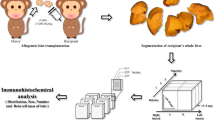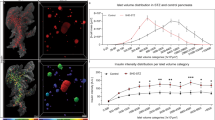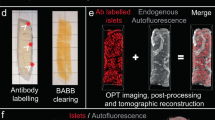Abstract
Type 1 diabetes mellitus is characterized by the selective destruction of insulin-producing beta cells, which leads to a deficiency in insulin secretion and, as a result, to hyperglycemia. At present, transplantation of pancreatic islets is an emerging and promising clinical modality, which can render individuals with type 1 diabetes insulin independent without increasing the incidence of hypoglycemic events. To monitor transplantation efficiency and graft survival, reliable noninvasive imaging methods are needed. If such methods were introduced into the clinic, essential information could be obtained repeatedly and noninvasively. Here we report on the in vivo detection of transplanted human pancreatic islets using magnetic resonance imaging (MRI) that allowed noninvasive monitoring of islet grafts in diabetic mice in real time. We anticipate that the information obtained in this study would ultimately result in the ability to detect and monitor islet engraftment in humans, which would greatly aid the clinical management of this disease.
This is a preview of subscription content, access via your institution
Access options
Subscribe to this journal
Receive 12 print issues and online access
$209.00 per year
only $17.42 per issue
Buy this article
- Purchase on Springer Link
- Instant access to full article PDF
Prices may be subject to local taxes which are calculated during checkout




Similar content being viewed by others
References
Shapiro, A. et al. Islet transplantation in seven patients with type 1 diabetes mellitus using a glucocorticoid-free immunosuppressive regimen. N. Engl. J. Med. 343, 230–238 (2000).
Shapiro, A., Ricordi, C. & Hering, B. Edmonton's islet success has indeed been replicated elsewhere. Lancet 362, 1242 (2003).
Moore, A., Bonner-Weir, S. & Weissleder, R. Non-invasive in vivo measurement of beta-cell mass in mouse model of diabetes. Diabetes 50, 2231–2236 (2001).
Ladriere, L., Leclercq-Meyer, V. & Malaisse, W. Assessment of islet beta-cell mass in isolated rat pancreases perfused with D-[(3)H]mannoheptulose. Am. J. Physiol. Endocrinol. Metab. 281, E298–E303 (2001).
Malaisse, W. & Ladriere, L. Assessment of B-cell mass in isolated islets exposed to D-[3H]mannoheptulose. Int. J. Mol. Med. 7, 405–406 (2001).
Schmitz, A. et al. Synthesis and evaluation of fluorine-18 labeled glyburide analogs as beta-cell imaging agents. Nucl. Med. Biol. 31, 483–491 (2004).
Moore, A. et al. MR imaging of insulitis in autoimmune diabetes. Magn. Reson. Med. 47, 751–758 (2002).
Moore, A., Grimm, J., Han, B. & Santamaria, P. Tracking the recruitment of diabetogenic CD8+ T cells to the pancreas in real time. Diabetes 53, 1459–1466 (2004).
Lu, Y. et al. Bioluminescent monitoring of islet graft survival after transplantation. Mol. Ther. 9, 428–435 (2004).
Fowler, M. et al. Assessment of pancreatis islet mass after islet transplantation using in vivo bioluminescence imaging. Transplantation 79, 768–776 (2005).
Massoud, T. & Gambhir, S. Molecular imaging in living subjects: seeing fundamental biological processes in a new light. Genes Dev. 17, 545–580 (2003).
Moore, A., Medarova, Z., Potthast, A. & Dai, G. In vivo targeting of underglycosylated MUC-1 tumor antigen using a multi-modal imaging probe. Cancer Res. 64, 1821–1827 (2004).
Moore, A., Weissleder, R. & Bogdanov, A., Jr. Uptake of dextran-coated monocrystalline iron oxides in tumor cells and macrophages. J. Magn. Reson. Imaging 7, 1140–1145 (1997).
Bulte, J.W. et al. Magnetodendrimers allow endosomal magnetic labeling and in vivo tracking of stem cells. Nat. Biotechnol. 19, 1141–1147 (2001).
Bulte, J., Duncan, I. & Frank, J. In vivo magnetic resonance tracking of magnetically labeled cells after transplantation. J. Cereb. Blood Flow Metab. 22, 899–907 (2002).
Arbab, A. et al. Efficient magnetic cell labeling with protamine sulfate complexed to ferumoxides for cellular MRI. Blood 104, 1217–1223 (2004).
Jirak, D. et al. MRI of transplanted pancreatic islets. Magn. Reson. Med. 52, 1228–1233 (2004).
Josephson, L., Tung, C., Moore, A. & Weissleder, R. High-efficiency intracellular magnetic labeling with novel superparamagnetic-Tat peptide conjugates. Bioconjug. Chem. 10, 186–191 (1999).
Bulte, J. et al. Neurotransplantation of magnetically labeled oligodendrocyte progenitors: magnetic resonance tracking of cell migration and myelination. Proc. Natl. Acad. Sci. USA 96, 15256–15261 (1999).
Lewin, M. et al. Tat peptide-derivatized magnetic nanoparticles allow in vivo tracking and recovery of progenitor cells. Nat. Biotechnol. 18, 410–414 (2000).
Arbab, A. et al. Characterization of biophysical and metabolic properties of cells labeled with superparamagnetic iron oxide nanoparticles and transfection agent for cellular MR imaging. Radiology 229, 838–846 (2003).
Zhan, Y. et al. Activated macrophages require T cells for xenograft rejection under the kidney capsule. Immunol. Cell Biol. 81, 451–458 (2003).
Davalli, A. et al. Vulnerability of islets in the immediate posttransplantation period. Dynamic changes in structure and function. Diabetes 45, 1161–1167 (1996).
Acknowledgements
Human pancreatic islets were obtained through The Islet Cell Resource Center, Division of Clinical Research, US National Institutes of Health (NIH). This study was supported in part by NIH grant DK071225 to A.M. The authors would like to acknowledge J. Lock and V. Tchipashvili (Joslin Diabetes Center), J. Moore and Pamela Pantazopoulos (Martinos Center for Biomedical Imaging, MGH) for technical support in animal surgery, and J. Pratt for assistance with imaging islet phantoms. Confocal microscopy was performed at the Confocal Microscopy Core at Massachusetts General Hospital with technical assistance from I.A. Bagayev. Electron microscopy was performed at the W.M. Keck Microscope Facility at the Whitehead Institute (Massachusetts Institute of Technology) with technical assistance from N. Watson.
Author information
Authors and Affiliations
Corresponding author
Ethics declarations
Competing interests
The authors declare no competing financial interests.
Supplementary information
Supplementary Figure 1
Confocal microscopy of frozen islet sections. (PDF 120 kb)
Supplementary Figure 2
Electron microscopy of human pancreatic islets labeled with iron oxides. (PDF 290 kb)
Supplementary Figure 3
Representative T2 map showing significant (P = 0.0003) difference between labeled and unlabeled grafts. (PDF 54 kb)
Supplementary Figure 4
Representative T2 map of NOD-SCID mice 2 weeks after transplantation. (PDF 54 kb)
Supplementary Figure 5
Excised kidneys of NOD-SCID 10 d after transplantation. (PDF 112 kb)
Supplementary Figure 6
Confocal microscopy of frozen kidney sections 188 d after transplantation. (PDF 755 kb)
Supplementary Figure 7
Optical imaging of excised liver with transplanted labeled islets. (PDF 34 kb)
Rights and permissions
About this article
Cite this article
Evgenov, N., Medarova, Z., Dai, G. et al. In vivo imaging of islet transplantation. Nat Med 12, 144–148 (2006). https://doi.org/10.1038/nm1316
Received:
Accepted:
Published:
Issue Date:
DOI: https://doi.org/10.1038/nm1316
This article is cited by
-
B-Glycine as a marker for β cell imaging and β cell mass evaluation
European Journal of Nuclear Medicine and Molecular Imaging (2024)
-
Early-Phase Luciferase Signals of Islet Grafts Predicts Successful Subcutaneous Site Transplantation in Rats
Molecular Imaging and Biology (2021)
-
Facilitating islet transplantation using a three-step approach with mesenchymal stem cells, encapsulation, and pulsed focused ultrasound
Stem Cell Research & Therapy (2020)
-
Magnetoliposomes as Contrast Agents for Longitudinal in vivo Assessment of Transplanted Pancreatic Islets in a Diabetic Rat Model
Scientific Reports (2018)
-
Non-invasive in vivo determination of viable islet graft volume by 111In-exendin-3
Scientific Reports (2017)



